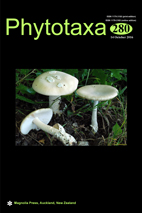Abstract
Cerarioporia cystidiata gen. et sp. nov. is proposed on the basis of a combination of a specific set of morphological characters and molecular (DNA-based) evidences. Cerarioporia is characterized by seasonal, resupinate basidiomata waxy when fresh drying resinous, a dimitic hyphal system with clamped generative hyphae and skeletal hyphae, distinctly thick-walled encrusted hymenial cystidia, and hyaline, thin-walled, smooth, fusiform basidiospores. Cerarioporia cystidiata was found growing on rotten angiosperm wood, and seems to cause a white rot in very humid tropical forest. Phylogenetic analyses based on n28S, and a combined n28S and ITS datasets show that Cerarioporia belongs to the core polyporoid clade of Polyporales.

